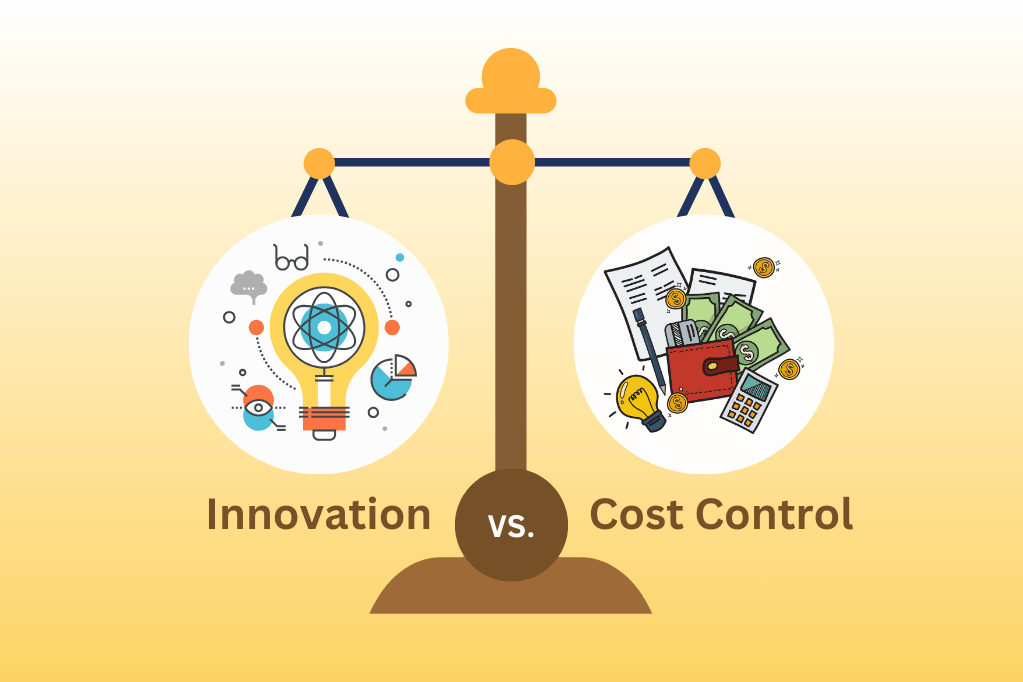Table of Contents
ToggleImagine being the CEO of your own company with a $10 million budget, faced with numerous innovative ideas and ongoing initiatives to fund. How would you allocate your budget? Which investments would you prioritize? Running a successful business requires more than just developing and selling products; it involves making strategic decisions. Balancing innovation with cost control is a significant challenge. Innovation fuels growth but often comes with high costs. The key is finding a balance that enables advancements without risking financial stability. This article explores strategies like the Lean Start-up approach and participatory budgeting through lean portfolio management to achieve this balance.
Understanding the Landscape: Challenges and Strategies
Balancing innovation with cost control presents several challenges:
- Knowing which product to invest in: Companies need to identify which products or services warrant investment to maximize returns.
- Managing investments across horizons: Spreading investments wisely between short-term, medium-term, and long-term goals is essential.
- Controlling cost overruns: Keeping expenses within budget while innovating can be daunting.
- Effective forecasting: Efficient forecasting helps manage financial, people, and resources effectively.
- Deciding to pivot or persevere: Continuously assessing whether to continue with the current strategy or make changes is vital for success.
To tackle these challenges, organizations can utilize Lean Portfolio Management (LPM). LPM offers a versatile approach that integrates frameworks, tools, and techniques to aid in investment prioritization, governance, and achieving operational excellence. The tools and techniques included are as follows:
- Investment by horizon
- Participatory budgeting
- Lean budgeting
- Lean start-up approach
Leveraging Lean Portfolio Management (LPM)
LPM is a strategic approach that aligns strategy with the execution of engineering and operational activities. It helps organizations to prioritize initiatives and projects based on their potential value and strategic fit, ensuring efficient allocation of resources. Key elements of LPM include:
- Decision-making for investment horizons: LPM helps in evaluating and prioritizing projects across different horizons.
- Financial management: Provides a framework for tracking investments and returns, enabling better financial control.
- Operational excellence: Ensure the consistent and proper implementation of strategic initiatives, aligning them with company standards.
Investment by Horizon
Investing by horizon involves categorizing investments into short, medium, and long-term goals. This approach helps in managing financial risks and aligning innovation with strategic objectives.
- Short-term investments: Focus on enhancing current offerings.
- Medium-term investments: Develop new products or services expected to generate revenue within a few years.
- Long-term investments: Invest in high-risk, high-reward innovative projects that could transform the industry.
Organizations can prioritize tasks across different horizons, enabling a diversified portfolio and budget allocation that encourages innovation.
Participatory Budgeting (PB)
PB engages employees, customers, and key stakeholders in the budget allocation process by enhancing transparency and accountability. By incorporating diverse perspectives, strategic decisions are informed and well-rounded. This method can also be applied to prioritize features and business capabilities during the product discovery process. (More about PB – https://www.participatorybudgeting.org/about-pb/)
Lean Budgeting
Another framework for financial management is lean budgeting. Lean Budgeting focuses on empowerment, transparency, continuous improvement, and waste reduction. This is done through the following key components:
- Empowering teams: Teams manage their budgets, making them more flexible and accountable for financial decisions.
- Transparency: Encourages open communication about resource allocation and financial constraints. By making the work and cost visible, it creates awareness and accountability across the organization.
- Innovation within constraints: Teams are motivated to innovate efficiently within budget limits and promote the economic approach to decision-making, project selection, prioritization, execution, spend, etc.
The Lean Start-Up Approach
To support operational excellence, the Lean start-up approach emphasizes iterative development and customer feedback loops. This method allows companies to quickly test and validate ideas, minimizing resource wastage. Here’s how it helps address key challenges:
- Cost overruns: By focusing on MVPs (Minimum Viable Products), companies can reduce the risk of overspending on unvalidated ideas while double-downing on products that proved to be desirable, viable, and feasible.
- Investment management: Regular feedback and iterative processes ensure that only high-valued products and services continue to receive funding. Each product iteration undergoes a review to determine whether to pivot or persevere.
Case Study and Implementation Insights
Lean Portfolio Management in Action
A healthcare company used Lean Portfolio Management to decide on investment horizons. To simplify initiative prioritization, each initiative was categorized by horizon and priorities were done based on these categories. Budgets were set by horizon and by value streams.
Each implementation team organized by value streams – aligning the development teams to the products and services they build/support. Each value stream manages their budgets within set thresholds. By aligning finance with this new model, they recognized costs (e.g., Opex vs. Capex) based on agile product development’s iterative approach.
This organization took a holistic view to their lean portfolio management model that allowed them to build innovative products without losing sight on the importance of cost management to ensure the longevity of the company.
Future Trends and Concluding Thoughts
The landscape of innovation and cost control is continuously evolving. Emerging trends such as AI-driven project management and real-time financial analytics are poised to further enhance the balance between innovation and cost control.
In conclusion, balancing innovation with cost control requires a structured, strategic approach. By leveraging strategies within lean portfolio management, companies can drive innovation and meet customer needs while maintaining financial stability. It requires an investment from the organization and taking a holistic approach to create an innovative and cost-conscious ecosystem.
Call to Action
Ready to implement these strategies in your organization? Start by evaluating your current approach to innovation and cost control. Explore our resources and tools to help you on this journey. Invest in developing organizational capability by leveraging industry experts, course offerings, and getting hands-on experience. Balance the scale and achieve economical sustainable growth in today’s dynamic business landscape.
